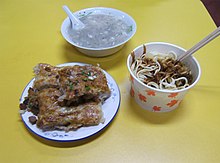Hot dry noodles: Difference between revisions
Reverted 1 edit by 128.146.115.243 (talk): Weasel. (TW) |
Cold Season (talk | contribs) m Cold Season moved page Re gan mian to Reganmian |
(No difference)
| |
Revision as of 23:34, 2 June 2012
| Hot dry noodles | |||||||||||
|---|---|---|---|---|---|---|---|---|---|---|---|
 Re gan mian (on right) with soup (gui hua hu mi jiu) and dou pi | |||||||||||
| Traditional Chinese | 熱乾麵 | ||||||||||
| Simplified Chinese | 热干面 | ||||||||||
| Literal meaning | hot dry noodles | ||||||||||
| |||||||||||
This article needs additional citations for verification. (January 2009) |

Re gan mian (Chinese: 热干面, literally Hot and Dry Noodles or Hot Braised Noodles ) is a traditional dish of Wuhan, the capital of the Hubei province in central China. [1][2]It is made of noodles called jian mian (碱面) with a mixture of sauces and dried vegetables. Many stalls [3]that make re gan mian will have their own variations in seasoning, creating signature tastes for individual stands or localities. The typical bowl of re gan mian will have soy sauce, sesame paste, pickled vegetables, chopped garlic chives and chili oil.
The noodles [4]are 80% pre-cooked, mixed with cooking oil, and allowed to dry. When preparing re gan mian, the noodles are placed into a Chinese strainer (a cone-shaped strainer) and dipped briefly into boiling water and then swirled and drained. The noodles are poured into a paper bowl and the sauce and pickled vegetables are poured on top. Chili oil is used in the seasoning of re gan mian. The noodles and ingredients before eating. Re gan mian is a popular local breakfast sold in road-side stalls or from push-carts. Re gan mian is popular for locals for every season of the year as breakfast, lunch, dinner or just a snack. Re gan mian as of late 2008 was priced from 2–3(yuan, equivalent to 30–50 cents (AU) each depending on the retailer. Wuhan's re gan mian, along with Shanxi's dao xiao mian (knife-cut noodles), Liangguang's yi fu mian, Sichuan's dan dan mian, and northern China's zhajiang mian, are collectively referred to as "China's five famous noodles."[5]
The origin of "Re gan mian"
In the early of 1930s, there was a small restaurant operated by Bao Li, who made a living by selling jellies and noodles in soup near a temple in Hankou. One day, the weather was so hot that he did not sold out his noodles. Li was afraid that his noodles would spoil and turn sour. Then he strained the water from the noodles and put on a chopping board. However, a careless made him spit the oil bottle nearby. Suddenly, the oil was poured over the noodles. On this situation, Li had no choice but mixing them with oil and cool the noodles. The next morning, Li dipped the oiled noodles into boiling water and then swirled and drained. Then he poured some source and pickled vegetables on top. The noodles are reeky and smell so good, and the delicious smell goes around. People crowded round bought these noodles, and they ate heartily. Someone asked Li what the name of the noodle is. He blurted out “Re gan mian”. Then re gan mian became famous after this.[6]
Variety
In 1933, there are three kinds of re gan mian, which are quanliao re gan mian, shrimp re gan mian, and chashao re gan mian. Until in June of 1996, there are eighe kinds of re gan mian, which are quanliao re gan mian, shrimp re gan mian, chashao re gan mian, pork re gan mian, zhajiang re gan mian, fish re gan mian, sanxian re gan mian, and fruit re gan mian. In 2005, a new kind of re gan mian appeared, which is called red oil re gan mian.
See also
References
- ^ http://www.instructables.com/id/Hot-and-Dry-Noodles-Re-Gan-Mian-/
- ^ http://www.foreignercn.com/index.php?option=com_content&view=article&id=4486:hot-dry-noodles-&catid=41:chinese-cuisine&Itemid=113
- ^ http://www.travelchinaguide.com/cityguides/hubei/wuhan/dining-snacks.htm
- ^ http://www.chinacanuck.com/chinablog/re-gan-mian-the-real-deal.htm/
- ^ "Hot Dry Noodles" (热干面), BBC News, 12 October 2005.
- ^ http://kaleidoscope.cultural-china.com/en/8K3774K10450.html
- ^ "Re gan mian".
